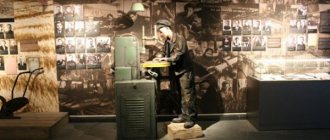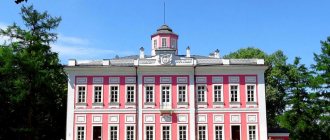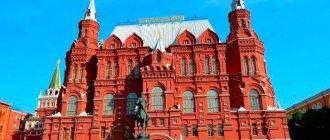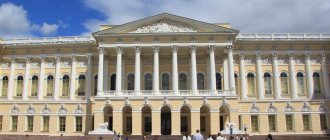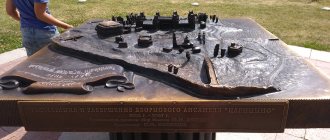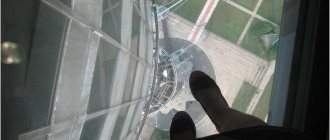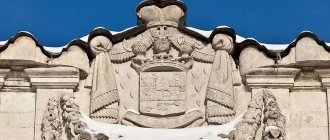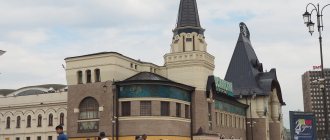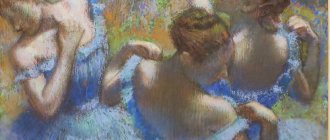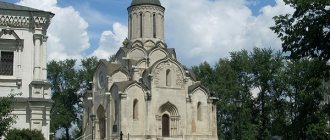The Moscow Museum of Archeology is located in an underground pavilion at a depth of 7 meters in the historical center of the city, directly on the site of large-scale archaeological excavations of 1993–1996.
Archaeological Museum of Moscow – museum of antiquity and excavations of the capital
The Museum of Antiquity gives an idea of the medieval capital, the history of the development of the territory of modern Manezhnaya Square, and contains general information about the methods of archaeological research.
History of the creation of the Moscow Museum of Archeology
In the mid-90s. Major archaeological work was carried out on Manezhnaya Square in the center of Moscow. They became part of the reconstruction of the square and the construction of a shopping mall.
During the work, scientists discovered a deep cultural layer, saturated with historical artifacts and household items from different eras. The remains of stone foundations dating back to the 18th and 19th centuries, log buildings, plank roads, and drainage pipes from the 16th-17th centuries were found. Household items include money, utensils, weapons, jewelry, tiles.
The main discovery was the preserved stone supports of the Resurrection, or Kuryatny, bridge. In the XVII-XVIII centuries. The bridge towered over the Neglinnaya River. The find helped to reconstruct the approximate development plan for Zaneglimenye, a medieval district of Moscow located on the right bank.
As a result of the work, the Moscow Museum of Archeology was opened in 1997 to celebrate the 850th anniversary of the capital. It is located below ground level, at a depth of 7 m, in the place of Manezhnaya Square where archaeological work was carried out. This location of a public educational object is rare and makes it stand out among cultural institutions in Moscow.
The exhibition halls of the museum are located on 3 levels, one below the other. The absence of windows and sunlight is compensated by a well-thought-out lighting system, which ensures a comfortable viewing of the exhibition.
The exhibits are displayed in glass cases and are organized according to types of handicrafts and chronologically.
Museum expositions
The Museum of Archeology of Moscow presents exhibitions telling about the life of Moscow before the 19th century through scientific and historical materials, found artifacts and household items. Moreover, ancient coins, architectural remains in the form of pavements, foundation buildings and well logs were found, which allow us to recreate a picture of life at that time.
On display cases and stands you can see pharmaceutical bottles, porcelain products, cutlery, work tools and children's toys (whistles, rattles, balls), as well as products made of ceramics, birch bark, and clay.
The hall displays models of the Resurrection Bridge of the 18th-19th centuries, the Kremlin and Kitay-gorod of the 17th century, Manezhnaya Square of the 19th century, which allows you to see old Moscow “live”.
The Moscow Museum of Archeology is very popular because it presents an exhibition dedicated to treasures: the Ipatievsky treasure (so named because it was found on Ipatievsky Lane) was found in a wooden barrel in which weapons were stored, as well as the Spanish treasure, consisting of more than 3000 old Spanish coins.
However, the first treasure was found in 1996 on the territory of Gostiny Dvor and represents valuable exhibits: silver glasses, silver bowls, about 300 foreign coins and more than 20 thousand Old Russian silver coins. Scientists believe that the treasure was hidden around the 17th century in the 40s.
A separate room is dedicated to archaeologists and their work. The tools with which excavations are carried out are shown, diaries where all stages of the excavation are recorded, what was found, what remains to be done, as well as an interactive map that shows where excavations are currently being carried out.
Development today
Soon after the museum opened, technological problems were identified that had a negative impact on the exhibition. The central exhibit was damaged: due to a violation of the waterproofing, the historical supports of the Kuryatny Bridge became covered with fungus. In 2011, the museum was closed for complete reconstruction.
During the renovation work, the ventilation system was modernized, fire-fighting equipment was installed, and an automatic access control system was set up.
The interior spaces were redesigned and computers were installed in the halls. For the convenience of people with disabilities, the museum is equipped with lifts and ramps. Technological innovations have appeared for virtual acquaintance with exhibits.
The re-opening of the museum took place in May 2015.
Today, the binoculars installed in the center of the first hall, which look like periscopes from the outside, are of great interest to visitors. Guests can be visually transported back to past eras and see what the area around the Resurrection Bridge looked like in the Middle Ages.
Employees of the Museum of Archeology conduct excursions and go out to give lectures.
Interactive events are possible upon reservation:
- “Birthday at the museum. Traveling in a time machine."
- “Birthday at the museum. X-pedition.”
- “Graduation program. A leap into the past."
Children over 7 years old attend the “Entertaining Archeology” course. They get acquainted with archaeological artifacts found within the borders of Moscow and study the history of the capital from the exhibits. The “School of Novice Archaeologists” is open for high school students. Students learn to distinguish artifacts from different eras.
Excavation layout.
Moscowolk
- Created: 05/22/2015 14:36
On May 18, 2015, after a major renovation, the Museum of Moscow Archeology opened on Manezhnaya Square. It is located in an underground pavilion at a depth of 7 meters, on the site of large-scale archaeological excavations carried out on Manezhnaya Square in the 90s. Initially, the Moscow Museum of Archeology was opened in the fall of 1997 in the very heart of the capital during the celebration of its 580th anniversary.
In 1997, the Moscow Museum of Archeology was opened with serious technological violations, so after only 15 years it had to be reconstructed.
Today, the museum has replaced utility networks, modernized ventilation, lighting and fire safety systems, partially redesigned the interior, installed an automated access control system, and now has the most modern museum equipment
The underground descent has been equipped for visitors with limited mobility
Entrance fees:
full - 300 rubles (by the way, in the museum there are no distinctions between a Russian visitor and a foreigner)
preferential - 150 rubles (children aged 7 to 17 years)
At the center of the museum’s exhibition are the foundations of the 18th-century Resurrection Bridge, discovered during excavations.
The bridge was thrown across the Neglinnaya River from the Resurrection Gate to the road to Tver. Built during the time of Boris Godunov and filled in after the fire of 1812, the Resurrection Bridge is a witness to several centuries of the city’s life.
Model of the Resurrection Bridge and the surrounding area. The bridge connected the White City with Kitay-Gorod and led directly to Red Square. Built by Peter Friedrich Heyden in the 1740s. The bridge was built of brick, and its abutments and cladding were made of white stone. Its length was 115 m, width 15 m. The bridge had five arches; the Neglinnaya River flowed through the fourth from the gate.
The upper tier contains materials from excavations on Manezhnaya Square.
Items from the burials of the Moiseevsky Monastery of the 17th-18th centuries
By pressing your hand on the cabinet drawer, a shelf with exhibits will slide out
Convenient and saves museum space, as there are a lot of excavations
The updated exhibition of the museum presents unique archaeological finds discovered both on Manezhnaya Square and in various districts of the capital
A treasure of European-style smoking pipes found on Basmannaya Street (Razgulay district)
Smoking pipes. Clay
On the top shelf there are wall and belt tiles from the 16th-18th centuries stretched out in a line. All the main types of these decorative ceramic tiles are presented here. Below you can see the “ware” range, which includes a wide variety of forms of ceramic products from the 14th-19th centuries: pots, tubs, jugs, mugs, egg capsules
Sightseeing, thematic, interactive excursions introduce visitors to the archaeological study of Manezhnaya Square and the methods of archaeological excavations, helping to more clearly imagine the life and way of life of the inhabitants of the Moscow region, starting from the Stone Age
Multimedia screens were installed in the museum halls - Museum Guide. Using this system, visitors will learn a variety of museum information: history, information, scientific facts
The museum now has binoculars - interactive glasses modules with which you can look into the past and see what the surrounding area of the bridge looked like in different eras.
Reconstruction of a small archaeological excavation (pit), revealing the white stone masonry of an early 17th century bridge across the Neglinnaya River
A giant treasure from the Old Gostiny Dvor. The treasure was discovered in the spring of 1996. The treasures were placed in two jugs. Next to the jugs lay two large copper ornamented dishes. Inside the jugs were stored 335 European coins - thalers and more than 95 thousand Russian silver kopecks.
Thalers minted from high-grade silver were brought from the United Provinces of the Netherlands, German states, Swiss cantons, Denmark, Sweden, and Norway. Most of the kopecks in this treasure were minted during the reign of Ivan the Terrible, Fyodor Ivanovich and Boris Godunov.
Items from ancient Russian settlements and burial mounds of the 12th-13th centuries. Lobed temporal rings
It’s gratifying that visitors come with children and show the younger generation history
The museum has a light show. “Shadows of the era” are projected onto the foundations of the Resurrection Bridge, which allow you to travel back in time.
There is no specific time when the light show is turned on. You just need to go up to any museum employee and simply ask to turn on
After renovation, the museum was transformed, became more modern, multimedia screens were installed in the halls
Treasure of Russian rubles of the 18th-19th centuries. The treasure was found in 1971 during excavation work in 3rd Perevedenovsky Lane. One hundred and six silver rubles belonged to the coinage of the time of Peter I, Anna Ioanovna, Elizaveta Petrovna, Peter III, Catherine II.
During the school year, special interactive educational programs are held for schoolchildren and students of different ages.
In the educational zone of the museum, children's master classes on archeology are held (for children from 5 years old). Young researchers will be able to take part in impromptu excavations and learn everything about the profession of an archaeologist. Tickets for interactive classes cost: 350 rubles per person and 600 rubles (2 people)
At the master class, you can, armed with a shovel and a brush, dig up various objects, even cow teeth :))
This long-awaited event happened in Moscow; after many years of reconstruction, the Museum of Archeology opened. The museum is famous and loved by Muscovites. Now, while walking in the center of Moscow, you can visit the archaeological museum
Tweet
Home page
www.moscowalk.ru
Add a comment
JComments
What to see
The museum's exposition includes more than 2,000 exhibits, covering the period of history from the era of the primitive communal system to the 19th century.
Museum exhibitions and collections
One of the most interesting collections of the museum is dedicated to the history of Moscow treasures. The largest of them, called the giant treasure, was recovered during excavations in Gostiny Dvor. It consists of 16 silver vessels filled with 95,000 silver coins and more than 300 coins from European countries. The treasure dates back to the 17th century.
In 1969, a wooden barrel containing equipment and weapons of a horseman and household utensils of the 16th-17th centuries was discovered in a cellar in Ipatievsky Lane.
A year later, another treasure was found in the same place, called “Spanish”. It consisted of 3397 silver coins minted in the Iberian Peninsula and 1 counterfeit bronze coin. The treasure was kept in a copper basin. Now both treasures are exhibited in the museum halls.
Other exhibits on display include household items of primitive people, collections of birch bark products, tiles, dishes, cutlery, weapons, tobacco pipes of the 18th-19th centuries, and toys. The products are systematized according to historical eras and practical purposes.
A separate exhibition is dedicated to archaeological scientists. The installation is located on the site of a real archaeological pit where research was carried out. Tools and instruments for carrying out work, notebooks and household items of archaeologists, and a map compiled by scientists are presented.
Exhibits in the museum.
The most interesting exhibits
The main exhibit of the museum are the supports of the Voskresensky (Chicken) Bridge, discovered during archaeological work in the mid-90s. Once upon a time, the bed of the Neglinnaya River ran on the territory of Manezhnaya Square, and the banks were connected by a wooden crossing.
The stone bridge in its place was first erected at the beginning of the 17th century. The architects decorated the railings with dovetail-shaped teeth, but in the middle of the 18th century. They decided to rebuild the structure, and the battlements were dismantled.
The bridge was 115 m long and 15 m wide. It consisted of 5 arches, but only one carried the practical load. Below it was a river bed. The main building material of the Kuryatny Bridge was brick; the supports and external cladding were made of white stone.
The history of the object continued during the era of the Napoleonic wars. After the capture of Moscow by Bonaparte's troops, the fire of 1812 and the subsequent expulsion of the French, the Neglinnaya River was enclosed in a ceramic collector, the Resurrection Bridge was covered with earth, and the space around it was built up. In the 30s. XX century The buildings were demolished, and Manezhnaya Square appeared. Moscow regained the Kuryatny Bridge only in the 90s. XX century
Among the ancient exhibits of the museum, flint figurines of the Neolithic era, the jaw of a young mammoth and finds from the early Iron Age are of interest.
Elements of the supports of the Resurrection Bridge.
Voskresensky Bridge
The main exhibit of the Moscow Museum of Archeology and the largest is the Resurrection Bridge of the Kitai-Gorod Wall, which connected the banks of the river; along it there was always trade in bread, gingerbread, sweets and pastries.
This is the second stone bridge designed and built in 1740 according to Heyden’s drawings on the site of the previous one. The bridge was made of white stone, 115 meters long and 15 meters wide.
But after a fire occurred in 1812, there was a major reconstruction on the territory of the Kremlin, the river was blocked and the bridge was completely filled up due to uselessness. And now you can see its foundations in the museum, which have survived to this day.
Practical information
The doors of the museum are always hospitably open to guests. Group excursions are available upon prior reservation.
Address, how to get there
The Museum of Archeology of Moscow is located at the address: Moscow, Manezhnaya Square, 1A.
How to get there by public transport:
- Metro: travel to the stations “Okhotny Ryad”, “Teatralnaya”, “Ploshchad Revolyutsii”. Continue on foot. The entrance to the museum is located on Manezhnaya Square, next to the corner of the Four Seasons Hotel Moscow building, opposite the monument to Marshal Zhukov.
- By land transport: by buses No. N1, N2, H11, M2, M3, M10, M27, 101, 144, 904 to the Manezhnaya Square stop, then on foot.
Location of the museum on the map.
Operating mode
Working days: Tuesday, Wednesday, Friday, Saturday, Sunday from 10:00 to 20:00, ticket office - until 19:00. On Thursday, visitors are welcome from 11:00 to 21:00, the ticket office is open until 20:00.
Day off is Monday.
Ticket prices
Entrance tickets are sold on site - at the museum box office - and on the official website.
Ticket categories:
- full - 300 rubles;
- preferential - 150 rubles;
- family (3 people) - 700 rub.
The following are entitled to a discounted ticket:
- children from 7 to 17 years old;
- students of technical schools and colleges;
- large families;
- persons of retirement age;
- disabled people of the second and third groups.
Free entry:
- heroes of the Soviet Union and the Russian Federation;
- WWII veterans;
- conscripted military personnel;
- people who survived the siege;
- concentration camp prisoners;
- children under 6 years old;
- full-time students of Russian universities;
- ISIC student card holders;
- disabled people of the first group;
- workers of state museums of Russia and CIS countries.
On the third Sundays of the month, admission to the museum is free.
Contacts
You can contact the administration by phone: +7 (495) 692-0020.
Opening
The museum was reborn 3 years later, on May 18, 2015. The opening was timed to coincide with Museum Day, after the “Night of Museums”.
Now the Moscow Museum of Archeology, in addition to being newly reconstructed (engineering communications were updated), is also equipped with the latest equipment. For example, you can admire the light show that is projected directly onto the Resurrection Bridge. The outlines of St. Basil's Cathedral, the Historical Museum and the Moscow Kremlin float by. Special binoculars, with which you can plunge into Moscow's past, await museum visitors on the second floor. They reflect Moscow of the 18th century: the Resurrection Bridge, which has not yet been covered with earth, strolling couples in love, officials running on official business and scurrying trade clerks.
The updated exhibition makes extensive use of modern technologies, but, according to the general director of the museum Alina Saprykina, they are not the main thing in the museum. And when the restoration work began, the founders gave instructions that high-tech and new museum equipment should not obscure the exhibits, because it was for their sake that this project was created in its time.
Visitor reviews
Elena, 41 years old, Tver: “The museum is located in the center, which is convenient. The exhibits date back to different eras - from the Paleolithic to the present day. I liked the archaeological pit, a sort of tribute to the people doing the difficult work of putting together the pieces of history.”
Egor, 34 years old, Moscow: “We were with the children during the winter holidays. Cool exhibition, unusually underground. Archaeological finds from different eras have been collected, the main exhibit being the foundations of the Resurrection Bridge. The children loved everything, especially the interactive binoculars.”
Alina, 37 years old, St. Petersburg: “Cosy, intimate, at the same time technologically advanced and stylish. A treasure trove of history. The Resurrection Bridge was impressive. My daughter bought a wonderful tin soldier at an affordable price. I recommend".
Alexander, 51 years old, Murmansk: “I visited with interest. Binoculars in the 17th century. just amazed. You can use the handles to rotate the eyepiece and admire the panorama of old Moscow. The female caretakers were polite and answered questions in detail. The impressions are positive."
Science archeology
The renovated Moscow Museum of Archeology not only introduces visitors to the material culture of past centuries, but also gives an idea of the science of archaeology. Thus, under one of the three arches of the Resurrection Bridge, an archaeological excavation (pit) with simple tools of an archaeological scientist is shown, which reveals the white stone masonry of the supports. In the hall for successive exhibitions there is now an exhibition introducing visitors to the history of Moscow archaeological research from the 1890s to the present day. There is also an interactive map that points to current archaeological sites. This information is constantly updated by museum staff.
Fashion exposition
Nowadays, it has become fashionable for all renovated museums to arrange open storage. The Moscow Museum of Archeology was no exception; the photo shows the equipment of a wealthy Muscovite of the 16th-17th centuries and household utensils. Also shown are tiles from the 16th-18th centuries and dishes - jugs, ceramic pots, mugs, bowls.
The museum has two thousand exhibits, among them - flint tools of the ancient people who lived in this area, remains of fabrics, they were found on the site of ancient settlements, ceramic jugs and glass bottles, utensils, dishes, bronze brooches and other decorations, parts of horse harness . A bone fork and spoon from the 16th and 17th centuries, metal buttons with carnelian dating back to the same time, a fragment of a leather bag, and a knitted sock tell stories about the life of our ancestors.
Treasures
Treasures occupy a special place in the museum. They were found on the territory of Moscow and transferred to the museum. Each discovery keeps its own story. For example, a Spanish treasure discovered in 1970 in Ipatievsky Lane was almost damaged by an excavator during the construction of the building. The copper basin contained 3,397 coins (about 75 kg of silver) in denominations of 2, 4, 8 reals, among them was a counterfeit bronze coin. They were minted in the 16th and 17th centuries at the mints of Spain and its colonies in Latin America.
Another treasure was found on the site of the Old Gostiny Dvor in the spring of 1996. When clearing the log foundation of a burnt house, two jugs were found in which 335 silver thalers were hidden; they were minted in Sweden, Germany, Denmark, the Netherlands and other countries, and about 100 thousand Russian kopecks from silver from the times of Ivan the Terrible and Boris Godunov. Judging by the size of the treasure, one can understand that the owner of such savings could have been a wealthy merchant. The “younger” coin is a Polish thaler from 1640 from the time of King Władysław, which means the money was hidden in the first half of the 17th century.
The rich life of the museum includes children's archaeological programs; they are designed for different ages.
